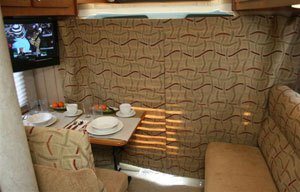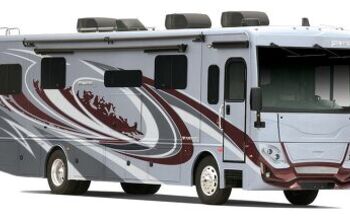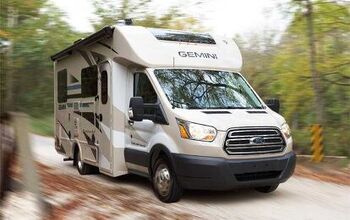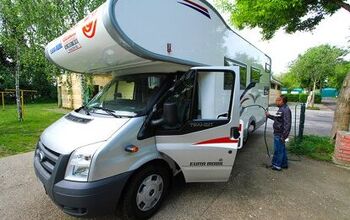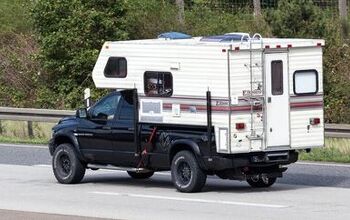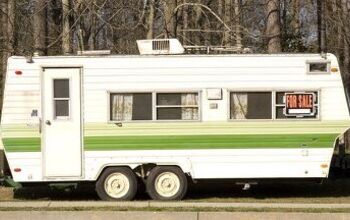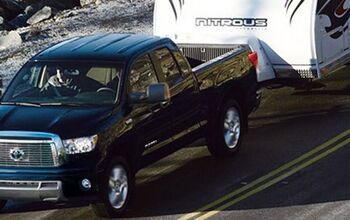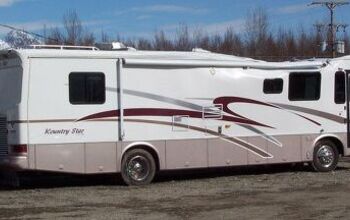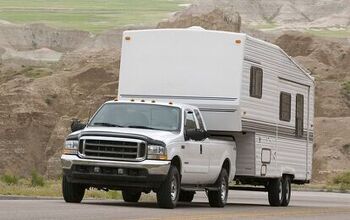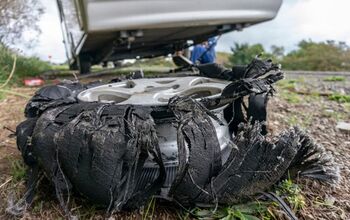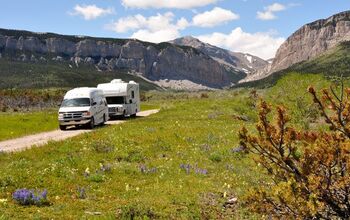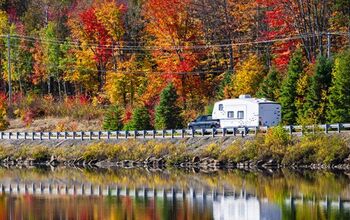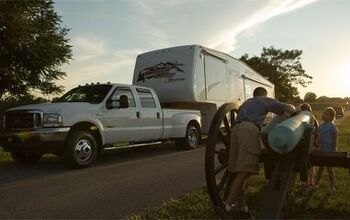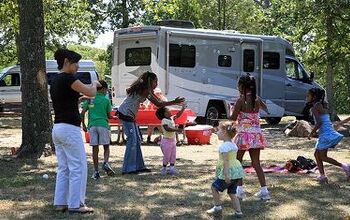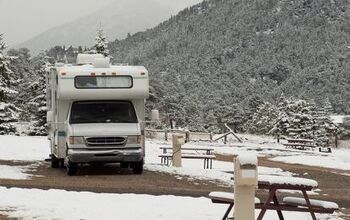2010 Winnebago View Profile 24DL Review
The first thing we noticed upon seeing photos of the View Profile 24DL for the first time was the amount of storage! My wife exclaimed that it had oodles of storage; I said it had gobs, and we finally agreed that the View Profile is equipped with lots of interior storage (especially in a coach of this size). We found that Winnebago’s engineers have filled every available space with some kind of storage. Wherever a cabinet, a drawer, or a cupboard wouldn’t fit, a nook, a tray, or a cranny is used.
View Profile’s slick silhouette does not allow space for an overhead bunk, but does have the skylight and a cubby hole on each side for miscellaneous things like hats, gloves, binoculars, etc. Also above the sunvisors are trays for books, note pads, maps, etc.
Immediately opposite the side entry door there are three cupboards above the Jensen TV; two doors open onto one cupboard while the third, left-most door hides the in-house Jensen AM/FM, alarm clock, and CD/DVD player entertainment unit. In the forward-facing bench seat below the above-mentioned cabinet (and directly behind the driver’s seat) is more storage along with the 300-watt inverter.
Across the aisle, on the curbside above the small inward-facing couch, are three more cabinet doors, all opening onto one large cupboard. The couch also provides storage, and it is where we kept our bedding.
Aft along the streetside is the bathroom. In this case, it is truly a bathroom and not just a water closet. Although the sink, placed against the forward bulkhead, is quite small, it’s the only thing in the bathroom that is, and there’s a cabinet below the sink (three cabinets are mounted to the wall above the sink—with a mirror in the door directly above the sink). The house-size toilet is a Thetford china unit with hand sprayer, and the shower is full-size with a flexible showerhead and skylight. It’s also equipped with an unusual “disappearing” shower curtain that automatically rolls back into its vertically-mounted roller box. The curtain has a five-year warranty, it’s made of mildew- and mold-resistant material, and each time it’s rolled up an included full-length wiper blade removes all the moisture from the curtain for storage.
Aft of the bathroom door a full-length mirror is installed for those last-minute touch-ups just before stepping out the door. You’ll probably fall into a habit of checking yourself in the mirror each time you go to the Norcold 5.5-cubic-foot refrigerator because the fridge is next in line toward the rear of the coach, and then you’re in the bedroom.
With the rear slide deployed, the foldable queen bed (60 inches by 75 inches) can also be fully deployed. Mattress is a 1/3-2/3 pair. The smaller portion is stacked on the larger portion for travel when the rear slideout is pulled in. If the 1/3 portion was cut again into two equal parts and stacked on one another, the bed could be used for a lounger during the day with the slide in but has no access to the below-bed storage from inside. The bed is quite large for such a small unit, although there is very little room for walking on each side of the bed. A privacy curtain for the bedroom hooks to three shallow hoops in the ceiling. Above the bed are two cabinets, and a book tray with reading light is on each side of the bed. And there is a rear window as well.
A wardrobe, or what we used to call a shirt closet, resides across the aisle from the fridge. And there are two fairly deep drawers below the wardrobe. On the rear-facing wall of the wardrobe, another Jensen LCD TV is mounted for viewing from the bed.
There is an unusual sink in the View Profile’s galley. For galley work or traveling the hinged cover is down, providing a safe, flat working space and no rattling during travel. For washing the cover is tilted upward and so is the pivoting faucet and the sink is deep enough to clean small pots and pans. The two-burner stove stovetop is also covered for additional flat counter space. Overhead is the combination microwave/convection oven, a stove hood with exhaust fan and light, and another cabinet. Above and to the right of the sink is the monitoring station to check status of holding tanks, water tank, etc., and the water heater and water pump switches. Above that is the keyed slideout control panel.
Back in the eating/lounging area, the table folds down into a small (42 x 44) bed. Since the bed does not block the aisle from the cab and is equipped with two seat belts, it could be ideal for those who enjoy traveling with dogs. There is enough space for at least two traveling kennels, which could be secured with the seat belts. If your dog doesn’t use a travel kennel, the table is padded and out of the way and should prove comfortable for a dog or two, depending on their sizes. The small side couch on the curbside also folds down and contacts across the aisle with the dinette bed, making an 82-x44-inch bed for a large night-time bed (it blocks easy access to the cab). Two pairs of snaps hold a privacy curtain to the rear cab bulkhead.
All the cabinet doors have securable latches, which I really like. While in camp spring hinges keep the doors closed but they are easily opened. When prepping for the road, a simple push on the latch knobs and they’re secure for the road. A simple push again when the next night’s stop is made and the doors are ready to open again.
With the table up in place, two adults can squeeze into the front-facing bench while traveling, but two children would be more comfortable. There is also a combination electrical outlet (120-VAC and 12 VDC) if someone wants to run a computer or connect a game set to the TV. Two seat belts are on the bench and two more on the couch. Coach sleeps four; seats six.
With the difference between the number of seat belts and sleeping accommodations in mind, if you have more than four people with whom you travel, and you’re thinking of upgrading from a small SUV and toy hauler package into a View Profile 24DL, don’t trade in the toy hauler. You can safely belt in six people while traveling in the View Profile 24DL and four can sleep in the coach while two can bunk in the toy hauler for the night and you’ll still have your toys with you. In 2009 the Sprinter’s pulling capacity was upped to 5,000 pounds (the upgraded hitch receiver is rated at a maximum of 5,000 pounds pull weight and 500 pounds of tongue weight)—which was carried over for 2010, but you still must adhere to both its GVWR of 11,030 pounds and its GCWR of 15,250 pounds, so please be aware to not exceed either of these limits.
Winnebago’s newly designed floorplan with a swoopy silhouette over the cab area proved to be both fuel- and family-friendly. The View Profile is fairly quick for a V6 diesel-powered coach (154-hp @ 3,400 rpm, 280 lb.-ft @ 1,200 rpm) with 0-50 mph, averaging 15.2 seconds. According to Winnebago gas mileage is said to be the “best in the industry” and factory estimated to be 16 mpg to 19 mpg with this Mercedes diesel. Speaking of fuel, the View Profile has a rather unusual location for its fuel filler tube. It’s beneath a fuel door, which is secured by the driver’s door when it’s closed.
The overhead skylight should provide additional lightness and brightness. But if you’re winter camping, covering all the glass with Winnebago’s optional light screens will go a long way toward cutting down your LPG bill. Otherwise, with the thermostat set at 70 degrees and the outside temperatures hovering in the teens, the furnace could run almost all night. Deploying the optional powered awning will add much to the enjoyment of RVing under a warm sun and the shade of an awning.
There are only warning lights for monitoring the engine’s operation, however, a few items can be viewed on the display in the dash’s I/P, which are the service due date, engine oil level, clock set, and outside temperature (or the digital speedometer can be accessed). The menu button is pushed to scroll through options (see pages 151 & 152 of the owner’s manual).
The View Profile is nimble, easy to handle, and at home in any mall’s parking lot. Just set the cruise control at the speed you want and it is maintained with the five-speed automatic transmission keeping pace with aplomb. Hold back, even though there was no exhaust brake, on downhills is also easily accomplished once the shifter’s operation is figured out. Unlike other shift selector panels, View Profile’s panel had no lower gears shown. Instead, “D” was the final selection on the bottom (starting with “P” at the top, then “R”, “N” and “D”, respectively). On the left side of the shifter is a “-” sign and on right side is a “+” sign. Tapping the shifter to the left drops the transmission to a lower gear (one tap per gear); tapping it to the right raises the transmission a gear.
With the exception of the window over the galley sink—which is equipped with a Venetian blind, all the “house” windows have pull-down day/night shades. Dumping is more involved on the View Profile than with the usual motorhome. This unit uses a pump to transfer the gray water to the main drain hose. The gray tank drain valve handle is located under the rear cap in the left rear corner. After dumping the black tank and closing that valve, you pull the gray tank valve and then operate the pump switch in the water center compartment until the tank is drained. If this is confusing, you’ll have to read your owner’s manual.
I’d say the cab is very utilitarian, especially when compared to the “house” portion of the View Profile. However, slipping into the delivery truck-type cab with rubber mats on the floorboards and non-swiveling captains’ chairs—although swiveling captains’ chairs are available optionally—was easily accomplished from either side with the wide doors. For being manual the seats are actually quite sophisticated and comfortable. They move fore and aft, they recline, move up and down, and have an adjustable lumbar support pillow.
Although there’s an abundance of interior storage, if you travel with children you will have to ration the weight of the gear and toys you allow them to bring along due to the somewhat limited GVWR. The View Profile weighs in with a wet weight of 9,700 pounds, when this is deducted from the GVWR; it leaves the coach with a 1,330-pound payload. Since six people can be strapped in safely, if there are six passengers, there’s not a lot of rated weight left for food, toiletries, clothing, bedding, etc., so the toys are going to be necessarily limited.
While you’re driving you’ll enjoy the View Profile’s cruise control, its tilt and telescoping power steering, anti-lock brakes, and electronic skid control. The 180-amp alternator keeps all three batteries (one chassis and two house) charged and ready for use. The two house batteries are also wired through a dash-mounted auxiliary starting switch in case a bit more boost is needed to turn over the Mercedes-Benz V6 on a cold morning.




